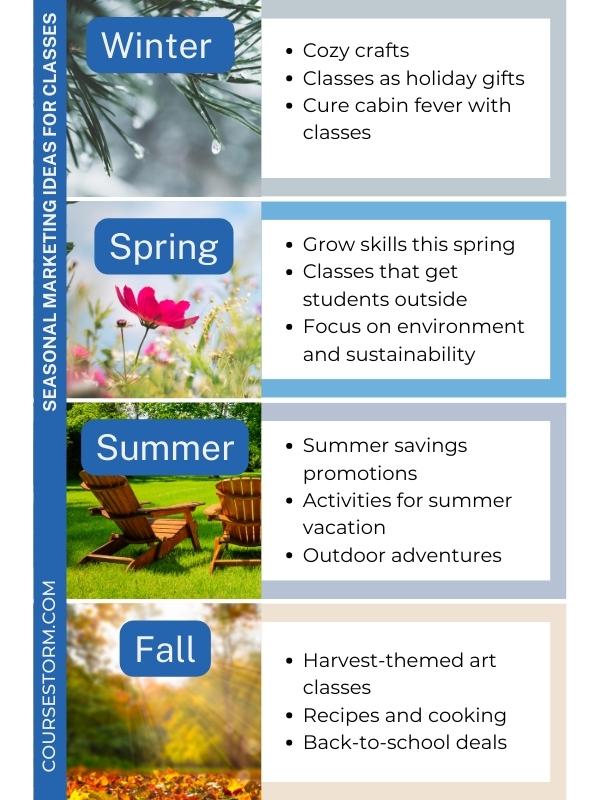Grow Your Program
How To's
How the Power of Seasonal Marketing Can Help Attract Students

There’s a reason you see more advertisements for florists in the weeks before Valentine’s Day. It’s the same reason gyms capitalize on the “new year, new you” weight loss trend in January. These businesses use seasonal marketing to make their promotions and campaigns feel more timely and relevant. Your organization can do the same for its courses.
Seasonal marketing taps into the collective emotions, experiences, memories, and traditions associated with each season to create compelling marketing. These campaigns provide a sense of urgency by making courses feel timely. They also drive engagement because they align with what students are likely to be thinking and feeling at any given time of year.
What Is Seasonal Marketing for Courses?
There are two ways to apply seasonal marketing to your courses. The first adopts a long-term mentality, while the second takes a more short-term view.
Each season is associated with different themes and events that you can use in your course marketing. For example, summer is a great time to promote classes that keep kids busy during school vacation.
In long-term seasonal marketing, you divide the calendar into the four seasons: winter, spring, summer, and fall. Each comes with its own themes and associations. For example, many people think of summer as a time for relaxation and fun. Winter is more cozy and often focuses on family traditions or holiday meals.
A long-term seasonal marketing strategy builds offers and promotions around each season. Here are some long-term seasonal promotion themes for each season:
- Winter: cozy crafts, classes as holiday gifts, classes as cures for cabin fever
- Spring: grow your skills this season, classes that get students outside
- Summer: summer savings promotions, outdoor adventures, classes to occupy kids during school vacation
- Fall: harvest-themed art classes, recipes and cooking, back-to-school deals

In short-term seasonal marketing, the calendar is divided by holidays. After July 4 comes Labor Day, then Columbus Day/Indigenous Peoples’ Day, then Veterans Day, and so on. You might also include special observances like National Senior Citizens’ Day or more playful holidays like Space Exploration Day.
A short-term seasonal marketing strategy is precise and focused. While it requires more work by constantly pivoting to the next holiday, it also creates a sense of urgency and the need to “act now,” prompting your audience to take action.
How to Use Seasonal Marketing to Boost Course Registration
Planning is essential for seasonal marketing. You should always be thinking at least a few months ahead of the current season or holiday. This kind of forward thinking takes effort, but can also help you connect with more students.
If you’re not used to thinking this way, it can take some getting used to. Here are four areas to consider if you want to try seasonal marketing for your classes.
1. Give Classes Seasonal Themes
Seasonal courses can make your course catalog feel fresh and relevant. Even if you’re teaching the same basic skills all year round, you can make them feel more timely by adding seasonal elements.
Here’s an example of how you might adjust a drawing class to fit different seasons:
- Winter: Learn to Draw Portraits as Holiday Gifts
- Spring: Draw a Mother’s Day Portrait
- Summer: Learn to Draw Portraits in Outdoor Settings
- Fall: Learn to Draw Cozy Portraits of Friends and Family
For theater programs, you might build workshops around plays that take place during particular seasons. Cooking classes can make recipes that use the fruits and vegetables of the season. By identifying key aspects of each season and connecting them to the subject matter, you can create an engaging class that feels relevant to the time of year.
2. Incorporate Nature-Based Activities
The seasons feel most immediate when you’re outside in nature. Give people an excuse to be outside and enjoy the seasons by offering classes that take advantage of the outdoors. For example, if you regularly offer CPR and first aid classes, consider planning a wilderness first aid class. Drawing and painting classes can take field trips outside to work en plein air. For a writing class, students could sit in a local park or garden and write down sensory images.
People in the modern world are hungry for ways to spend time outside and away from screens. Taking your classes outside can add a new dimension to your lessons and help people feel better overall.
3. Seek Out Unusual Holidays and Observances
These days, there is a holiday for every cause and interest. Whatever type of education program you’re running, there’s probably an observance day relevant to your interests. Here are just a few to start your creative juices flowing.
For Dance Programs:
- Jan 9, Choreographers Day
- April 29, International Dance Day
- May 25, Tap Dance Day
For Theater Programs:
- March 20, World Day of Theater for Children and Young People
- March 27, World Theater Day
- September 29, Broadway Musicals Day
For Museums and Art Programs:
- January 31, Inspire Your Heart With Art Day
- April 15, World Art Day
- April 21, World Creativity and Innovation Day
For Music-Related Programs:
- April 30, International Jazz Day
- May 25, National Sing Out Day
- October 1, International Music Day
For Writing Programs:
- January 5, National Screenwriters Day
- March 21, World Poetry Day
- April 1, National Poetry Month
These are just a tiny sampling of the dozens of arts-related holidays you could build campaigns or classes around. Nearly any subject or area of interest has a similar array of holidays to choose from. Do some research to find the ones that are most relevant to your program offerings.
4. Promote Classes as Gifts
Many people celebrate holidays by giving gifts. Beyond the winter holiday gifting season there’s Mother’s Day and Father’s Day, Valentine’s Day and Easter. Graduation season (May and June) and wedding season (June to September) are also prime gift-giving times.
Marketing classes as gifts is a great way to encourage registrations almost any time of year. The extra benefit is that gifted classes may introduce a whole new audience to your program. Build marketing campaigns around class gifting and make it easy for students to buy classes as gifts. Also consider promoting a shared experience gift with couples classes for Valentine’s Day or family classes around Mother’s and Father’s Day, or other family holidays.
Best Practices for Seasonal Marketing
Seasonal marketing is an effective approach to capture your audience’s attention and drive engagement. By understanding seasonal trends and embracing seasonal themes, you can build a strong connection with your students throughout the year.
Write course descriptions and titles that mention the season, and share seasonal promotions for your classes on your blog and social media.
Your seasonal classes will perform best if you make the connections clear and specific. Write course descriptions and titles that mention the season. Use your social media, blog articles, and other marketing materials to let students know about seasonal classes. Consider whether special seasonal promotions, discounts, or limited-time packages can help generate more engagement.
And as always, make it as easy as possible for your students to register for classes. CourseStorm offers streamlined student registration and payment processing software to make seasonal class registration simple. Your students will be able to easily sign up with friends and family, and fill their shopping cart with the classes of the season. Start your free trial now or contact us to learn more.

Greg Shula
Greg has spent a decade analyzing business and marketing performance metrics of the companies he has worked with. He uses his analytical mind and investigative skills to find trends and simple answers from complicated data sets. Greg is also an amateur photographer who loves to capture nature from new perspectives.
